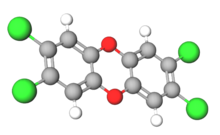2,3,7,8-Tetrachlorodibenzodioxin

| |

| |

| |
| Names | |
|---|---|
| Preferred IUPAC name
2,3,7,8-Tetrachlorooxanthrene | |
| Other names
2,3,7,8-Tetrachlorodibenzo[b,e][1,4]dioxine
Tetradioxin Tetrachlorodibenzodioxin Tetrachlorodibenzo-p-dioxin | |
| Identifiers | |
3D model (
JSmol ) |
|
| Abbreviations | TCDD; TCDBD |
| ChEBI | |
| ChEMBL | |
| ChemSpider | |
ECHA InfoCard
|
100.015.566 |
| KEGG | |
PubChem CID
|
|
| UNII | |
CompTox Dashboard (EPA)
|
|
| |
| |
| Properties | |
| C12H4Cl4O2 | |
| Molar mass | 321.96 g·mol−1 |
| Appearance | Colorless to white crystalline solid[1] |
| Density | 1.8 g/cm3 |
| Melting point | 305 °C (581 °F; 578 K) |
| 0.2 μg/L[2] | |
| log P | 6.8 |
| Vapor pressure | 1.5 × 10−9 mmHg |
| Hazards | |
| Occupational safety and health (OHS/OSH): | |
Main hazards
|
Developmental toxicant, Carcinogenic[1] |
| GHS labelling: | |
   
| |
| Danger | |
| H225, H304, H315, H336, H361, H373, H401, H410 | |
| P201, P202, P210, P233, P240, P241, P242, P243, P260, P264, P271, P273, P280, P301+P310, P303+P361+P353, P304+P340+P312, P308+P313, P331, P332+P313, P362+P364, P370+P378, P391, P403+P233, P403+P235, P405, P501 | |
| NFPA 704 (fire diamond) | |
| Flash point | 164.2 °C (327.6 °F; 437.3 K) |
| NIOSH (US health exposure limits): | |
PEL (Permissible)
|
none[1] |
REL (Recommended)
|
Ca[1] |
IDLH (Immediate danger) |
N.D.[1] |
| Safety data sheet (SDS) | MSDS |
Except where otherwise noted, data are given for materials in their standard state (at 25 °C [77 °F], 100 kPa).
| |
2,3,7,8-Tetrachlorodibenzo-p-dioxin (TCDD) is a
TCDD is the most potent compound (congener) of its series (polychlorinated dibenzodioxins, known as PCDDs or simply dioxins) and became known as a contaminant in Agent Orange, a herbicide used in the Vietnam War.[4] TCDD was released into the environment in the Seveso disaster.[5] It is a persistent organic pollutant.
Biological activity in humans and animals
TCDD and dioxin-like compounds act via a specific receptor present in all cells: the aryl hydrocarbon (AH) receptor.[6][7][8] This receptor is a transcription factor which is involved in the expression of genes; it has been shown that high doses of TCDD either increase or decrease the expression of several hundred genes in rats.[9] Genes of enzymes activating the breakdown of foreign and often toxic compounds are classic examples of such genes (enzyme induction). TCDD increases the enzymes breaking down, e.g., carcinogenic polycyclic hydrocarbons such as benzo(a)pyrene.[10]
These polycyclic hydrocarbons also activate the AH receptor, but less than TCDD and only temporarily.[10] Even many natural compounds present in vegetables cause some activation of the AH receptor.[11][12] This phenomenon can be viewed as adaptive and beneficial, because it protects the organism from toxic and carcinogenic substances. Excessive and persistent stimulation of AH receptor, however, leads to a multitude of adverse effects.[10]
The physiological function of the AH receptor has been the subject of continuous research.[13] One obvious function is to increase the activity of enzymes breaking down foreign chemicals or normal chemicals of the body as needed. There seem to be many other functions, however, related to the development of various organs and the immune systems or other regulatory functions.[13] The AH receptor is phylogenetically highly conserved, with a history of at least 600 million years, and is found in all vertebrates. Its ancient analogs are important regulatory proteins even in more primitive species.[8] In fact, knock-out animals with no AH receptor are prone to illness and developmental problems.[8] Taken together, this implies the necessity of a basal degree of AH receptor activation to achieve normal physiological function.
Toxicity in humans
In 2000, the Expert Group of the World Health Organization considered developmental toxicity as the most pertinent risk of dioxins to human beings.[14] Because people are usually exposed simultaneously to several dioxin-like chemicals, a more detailed account is given at dioxins and dioxin-like compounds.
Developmental effects
In Vietnam and the United States,
Cancer
It is largely agreed that TCDD is not directly
TCDD was classified by the
In 2004, an article in the International Journal of Cancer provided some direct epidemiological evidence that TCDD or other dioxins are not causing soft-tissue sarcoma at low doses, although this cancer has been considered typical for dioxins. There was in fact a trend of cancer to decrease.[29] This is called a J-shape dose-response, low doses decrease the risk, and only higher doses increase the risk, according to a 2005 article in the journal Dose-Response.[30]
Safety recommendations
The Joint FAO/WHO Expert Committee on Food Additives (JECFA) derived in 2001 a provisional tolerable monthly intake (PTMI) of 70 pg TEQ/kg body weight.[31] The United States Environmental Protection Agency (EPA) established an oral reference dose (RfD) of 0.7 pg/kg b.w. per day for TCDD[32] (see discussion on the differences in[3]). According to the Aspen Institute, in 2011, "The general environmental limit in most countries is 1,000 ppt TEq in soils and 100 ppt in sediment. Most industrialized countries have dioxin concentrations in soils of less than 12 ppt. The U.S. Agency for Toxic Substance and Disease Registry has determined that levels higher than 1,000 ppt TEq in soil require intervention, including research, surveillance, health studies, community and physician education, and exposure investigation. The EPA is considering reducing these limits to 72 ppt TEq. This change would significantly increase the potential volume of contaminated soil requiring treatment."[33][34]
Animal toxicology
By far most information on toxicity of dioxin-like chemicals is based on animal studies utilizing TCDD.
Developmental effects
Developmental effects occur at very low doses in animals. They include frank
Cancer
Cancers can be induced in animals at many sites. At sufficiently high doses TCDD has caused cancer in all animals tested. The most sensitive is liver cancer in female rats, and this has long been a basis for risk assessment.[43] Dose-response of TCDD in causing cancer does not seem to be linear,[25] and there is a threshold below which it seems to cause no cancer. TCDD is not mutagenic or genotoxic, in other words, it is not able to initiate cancer, and the cancer risk is based on promotion[16] of cancer initiated by other compounds or on indirect effects such as disturbing defense mechanisms of the body e.g. by preventing apoptosis or programmed death of altered cells.[23][7] Carcinogenicity is associated with tissue damage, and it is often viewed now as secondary to tissue damage.[16]
TCDD may in some conditions potentiate the carcinogenic effects of other compounds. An example is benzo(a)pyrene that is metabolized in two steps, oxidation and conjugation. Oxidation produces epoxide carcinogens that are rapidly detoxified by conjugation, but some molecules may escape to the nucleus of the cell and bind to DNA causing a mutation, resulting in cancer initiation. When TCDD increases the activity of oxidative enzymes more than conjugation enzymes, the epoxide intermediates may increase, increasing the possibility of cancer initiation. Thus a beneficial activation of detoxifying enzymes may lead to deleterious side effects.[44]
Sources
TCDD has never been produced commercially except as a pure chemical for scientific research. It is, however, formed as a synthesis side product when producing certain
The greatest production occurs from waste incineration, metal production, and fossil-fuel and wood combustion.[47] Dioxin production can usually be reduced by increasing the combustion temperature. Total U.S. emissions of PCCD/Fs were reduced from ca. 14 kg TEq in 1987 to 1.4 kg TEq in 2000.[48]
Cases of exposure

There have been numerous incidents where people have been exposed to high doses of TCDD.
- In 1976, thousands of inhabitants of
- In Times Beach, Missouri, several hundred people were poisoned by extremely high concentrations of TCDD by Russell Martin Bliss, who sprayed TCDD-contaminated waste oil on dusty roads to avoid large dust clouds. Bliss himself obtained the waste oil from NEPACCO, a company that produced Agent Orange. No one was ever charged in relation to the incident, and the city of Times Beach was abandoned and disincorporated following an investigation by the CDC and EPA. This is marked as the single largest contamination of a civilian area by TCDD in United Stateshistory.
- In Vienna, two women were poisoned at their workplace in 1997, and the measured concentrations in one of them were the highest ever measured in a human being, 144,000 pg/g of fat. This is about 100,000 times the concentrations in most people today and about 10,000 times the sum of all dioxin-like compounds in young people today. They survived but suffered from difficult chloracne for several years. The poisoning likely happened in October 1997 but was not discovered until April 1998. At the institute where the women worked as secretaries, high concentrations of TCDD were found in one of the labs, suggesting that the compound had been produced there. The police investigation failed to find clear evidence of crime, and no one was ever prosecuted. Aside from malaise and amenorrhea there were few other symptoms or abnormal laboratory findings.[51]
- In 2004, presidential candidate Viktor Yushchenko of Ukraine was poisoned with a large dose of TCDD. His blood TCDD concentration was measured 108,000 pg/g of fat,[52] which is the second highest ever measured. This concentration implies a dose exceeding 2 mg, or 25 μg/kg of body weight. He suffered from chloracne for many years, but after initial malaise, other symptoms or abnormal laboratory findings were few.[52]
- An area of polluted land in Italy, known as the Triangle of Death, is contaminated with TCDD from years of illegal waste disposal by organized crime.[53][54][55]
See also
- Dioxins and dioxin-like compounds
- Toxic Equivalency
References
- ^ a b c d e NIOSH Pocket Guide to Chemical Hazards. "#0594". National Institute for Occupational Safety and Health (NIOSH).
- S2CID 53459209.
- ^ a b c d e f g h i Tuomisto, Jouko (2019) Dioxins and dioxin-like compounds: toxicity in humans and animals, sources, and behaviour in the environment. WikiJournal of Medicine 6(1): 8 | https://doi.org/10.15347/wjm/2019.008
- ^ PMID 16445906.
- ^ S2CID 11814994.
- S2CID 22295283.
- ^ S2CID 20508397.
- ^ S2CID 34036181.
- S2CID 1913812.
- ^ PMID 17569696.
- PMID 16918318.
- ISBN 9781118140574.
- ^ S2CID 59603271.
- S2CID 216644694.
- PMID 16543362.
- ^ S2CID 24500449.
- ^ PMID 11156390.
- PMID 16977593.
- ^ PMID 19754930.
- ^ ISBN 978-92-832-1269-0.
- ^ IARC Working Group on the Evaluation of Carcinogenic Risk to Humans (2012). 2,3,7,8-tetrachlorodibenzopara-dioxin, 2,3,4,7,8-pentachlorodibenzofuran, and 3,3',4,4',5-pentachlorobiphenyl. Vol. 100F. International Agency for Research on Cancer. pp. 339–378.
- PMID 9199536.
- ^ PMID 16054739.
- PMID 14623487.
- ^ PMID 16977594.
- PMID 21718216.
- PMID 21441038.
- PMID 21810551.
- PMID 14712494.
- PMID 18648613.
- PMID 24804623.
- ^ Rice, Glenn. "EPA's Reanalysis of Key Issues Related to Dioxin Toxicity and Response to NAS Comments (External Review Draft)". cfpub.epa.gov. US EPA National Center for Environmental Assessment,Cincinnati Oh. Retrieved 16 December 2019.
- ^ "Health Effects". The Aspen Institute. August 2011. Retrieved 23 September 2019.
- ^ "Toxic Substances Portal" (PDF).
- PMID 6282188.
- ^ PMID 7899475.
- ^ S2CID 45117354.
- PMID 1585364.
- PMID 9299592.
- PMID 11485382.
- ^ PMID 15345345.
- S2CID 31562457.
- PMID 734660.
- ISBN 978-0-07-134721-1.
- S2CID 23115128.
- PMID 22200276.
- ^ DHHS: Report on Carcinogens, Twelfth Edition (2011) Archived 17 February 2013 at the Wayback Machine (accessed 2013-08-01)
- EPA's National Center for Environmental Assessment
- PMID 1826746.
- S2CID 6353869.
- PMID 11564625.
- ^ S2CID 24761553.
- PMID 15384216.
- ^ "Il triangolo della morte". rassegna.it. March 2007. Archived from the original on 15 February 2009. Retrieved 25 September 2014.
- ^ "Discariche piene di rifiuti tossici quello è il triangolo della morte". la Repubblica. 31 August 2004.

